
We thrive on the ability to stay constantly connected to the rest of the world through technology. But there are times when our devices hold us back, distracting us when we should be working on an important project or connecting with friends over dinner. Fortunately, a device that was first theorized over 200 years ago — the Faraday cage — offers a way to take ourselves offline, if only for a little while.
What Is a Faraday Cage?
Faraday cages, also known as Faraday shields, are enclosures of varying sizes and shapes that are made up of highly conducting materials. When an electric field is applied to the exterior of the cage, electrons in the conducting material are displaced so that one side of the cage becomes negatively charged, whereas the opposite side of the cage becomes positively charged. This induced electric polarization cancels out the external electric field almost entirely inside the conductors and, to a large extent, also in the nonconducting parts inside the enclosure, protecting its interior from electromagnetic waves.
An animation showing how a Faraday cage works.
Faraday cages get their name from British physicistMichael Faraday, who observed the effect in a series of experiments in the 1840s. Although named after Faraday, Benjamin Franklin and Giovanni Battista Beccaria had also observed and studied the phenomenon earlier.
For a Faraday cage to do its job, the conducting material needs to be relatively thick and the holes of the cage’s mesh must be smaller than the incident wavelength of the radiation. (In fact, using a solid cage instead of mesh is preferred for maximum protection.) Still, these devices aren’t able to completely block any type of interference or signal. RF waves can penetrate the cage depending on certain factors, such as the distance of the cage from a receiver or the frequency of the signal. Signals such as HF RFID are likely to break through a Faraday cage. These cages also aren’t able to block the earth’s magnetic field, so although a cellphone won’t get a signal inside the enclosure, a compass will still work.

The Sphinx Observatory in Switzerland uses a Faraday cage made up of wires to protect visitors from lightning strikes, which can occur even in clear weather. Image by Maksym Kozlenko — Own work. Licensed underCC BY-SA 4.0, viaWikimedia Commons.
Electromagnetics Research Brings About a Useful Device
For Michael Faraday’s famed experiments on this subject, he placed a metal ice bucket onto a wooden stool to insulate it from the ground and attached an electroscope to the contraption with a wire. Then, he took a metal ball charged with static electricity, attached it to a string, and slowly dropped the ball toward the bucket.
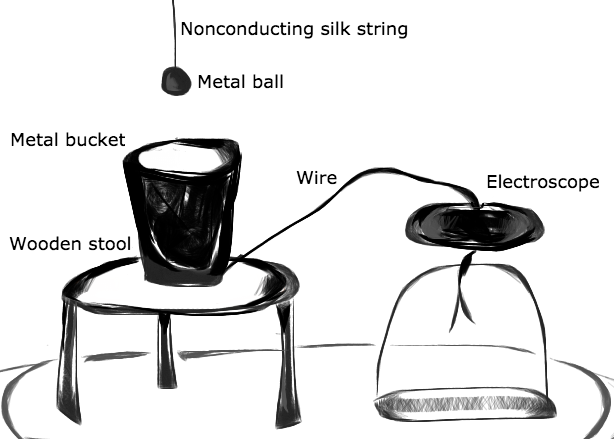
An illustration of the setup for Faraday’s ice bucket experiment.
When the ball reached the inside of the bucket, Faraday noticed that the electroscope registered a charge. The experiments showed that a charge was induced in the bucket through electrostatic induction and an opposite charge was induced on the inside of the bucket. Thus, when the ball touched the inside surface, the opposing charges canceled each other out.
To extend his research, Faraday coated a room in foil and struck the outside with a high-voltage electrostatic discharge. He again used an electroscope to prove that inside the room there was no presence of electric charge. This showed that an excess charge on a charged conductor only exists outside of the enclosure and does not affect anything that is kept inside of it.
Over the years, this knowledge has led to the use of Faraday cages in a variety of application areas and industries.
Personal Faraday Cages: An Antidote to Technology Dependence
Sending a text message or two at the dinner table might be fine, but constantly checking your cellphone could upset your host or other dining companions. To abate the temptation, a group of Dutch inventors developed a new use for Faraday cages just for this purpose.
CalledBlock, this device is a stylishly colored aluminum box that can hold up to six cellphones at a time. While the phones are in the box, they cannot transmit or receive a signal. The result? A soiree full of eye contact and thoughtful conversation. In a similar vein, cloth pockets and pouches use conductive material to block signals from a singular cellphone, but these devices are used more for privacy reasons. On the other hand, if you need to cut down on your device use to work on a project or even just finish a book, a personal Faraday cage might be a practical solution.

No phones!
Besides assisting us in our social lives, Faraday cages are, perhaps more commonly, used to improve our privacy, safety, and health.
Improving Consumer Privacy, Safety, and Medicine
Since the early 2000s, criminals have used RFID readers to read other people’s RFID chip information and steal their credit information and identities. To protect ourselves from RFID skimming, there are special wallets and bags that block RFID readers by using the technology behind Faraday shielding.
In aircraft, the passenger cabins act as large Faraday cages and are used to protect the crew and passengers from unexpected lightning strikes. (I would still put your phone inairplane modelike the flight attendants instruct.) Electricians who work on live wires can wear Faraday suits made with a conductive material that protects them from getting shocked or electrocuted by power discharges. For MRI machine rooms, the exterior is surrounded by a Faraday cage so that patient data is not disturbed by outside RF signals, helping doctors get as clear of an image as possible.

A Faraday suit is one example of modern Faraday shielding. These suits protect electrical linemen working on live wires from getting shocked. Image by Jesse A. Lora. Licensed underCC BY 2.0, viaFlickr Creative Commons.
Shielding and Blocking Electromagnetic Signals Beyond Faraday Cages
When performing antenna characterization, as well as electromagnetic interference (EMI) and electromagnetic compatibility (EMC) tests, we need a special type of measurement facility: an anechoic chamber.
By absorbing electromagnetic waves inside the chamber and blocking the incoming signals from the outside, it creates a virtually infinite space that has almost zero internal reflection and does not suffer from unwanted external RF noise, so the device-under-test in the chamber can be accurately measured without any interference. The exterior of the chamber is also finished with metallic plates or conductive coating that insulates the chamber from the outside RF noises. This insulation part basically works as a Faraday cage.
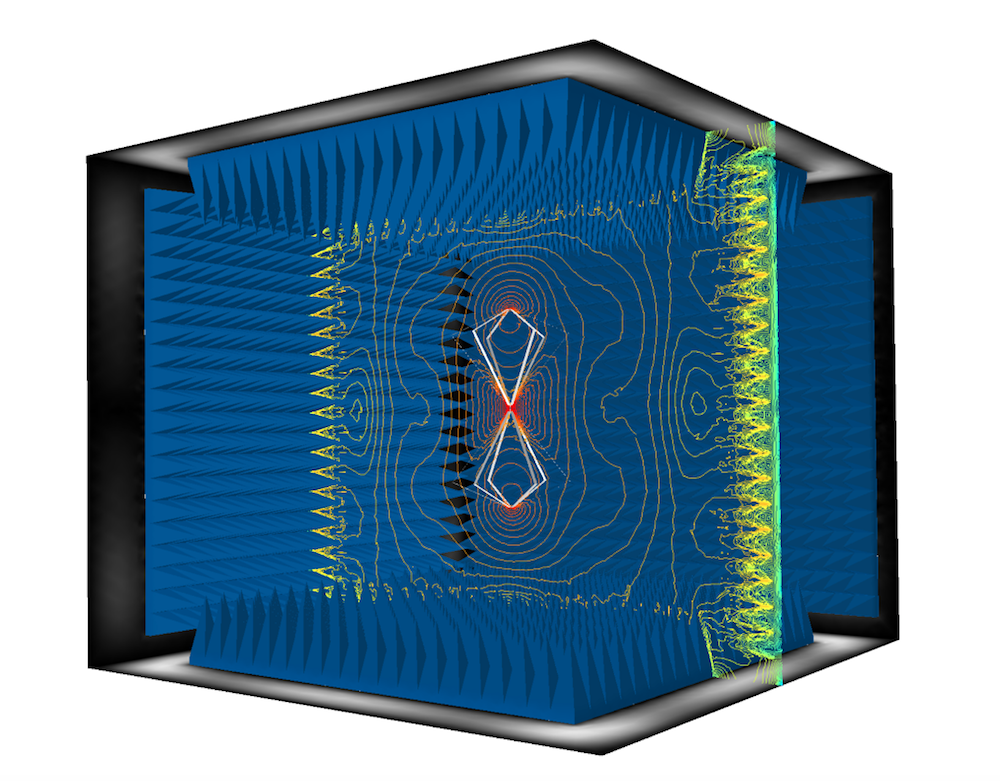
An RF Module Application Library example of an anechoic chamber, available with version 5.3 of the COMSOL Multiphysics® software. This example simulates a biconical antenna, popularly used in EMI and EMC tests, that is located at the center of a small anechoic chamber.
While you watch your lunch get heated up inside a microwave oven, you don’t worry about the microwave radiation heating up your eyeballs along with your food. The microwave oven cavity and the front window screen block the 2.45-GHz electromagnetic waves that contribute to the temperature rise of water molecules. It works as a small Faraday cage for that specific frequency.
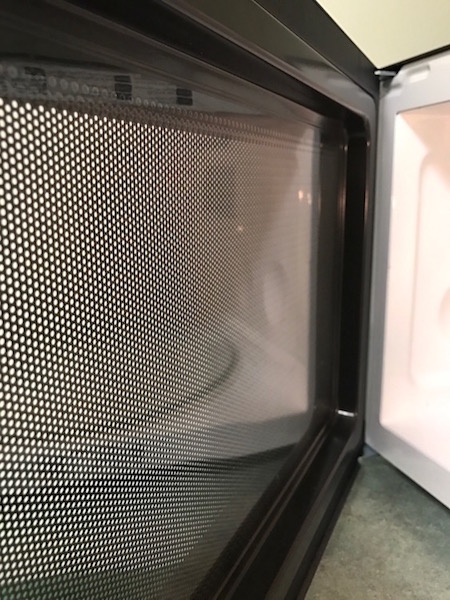
A close-up of a microwave oven door.
The front window consists of periodic holes over the metallic screen, so it performs as a frequency selective surface, such that the screen blocks the microwaves while passing light waves so you can see that the plate is rotating.
Afrequency selective surface, split ring resonatorconsists of periodic structures that may provide a bandpass or a bandstop frequency response. This example shows that only signals around the center frequency can pass through the periodic complementary split ring resonator layer.
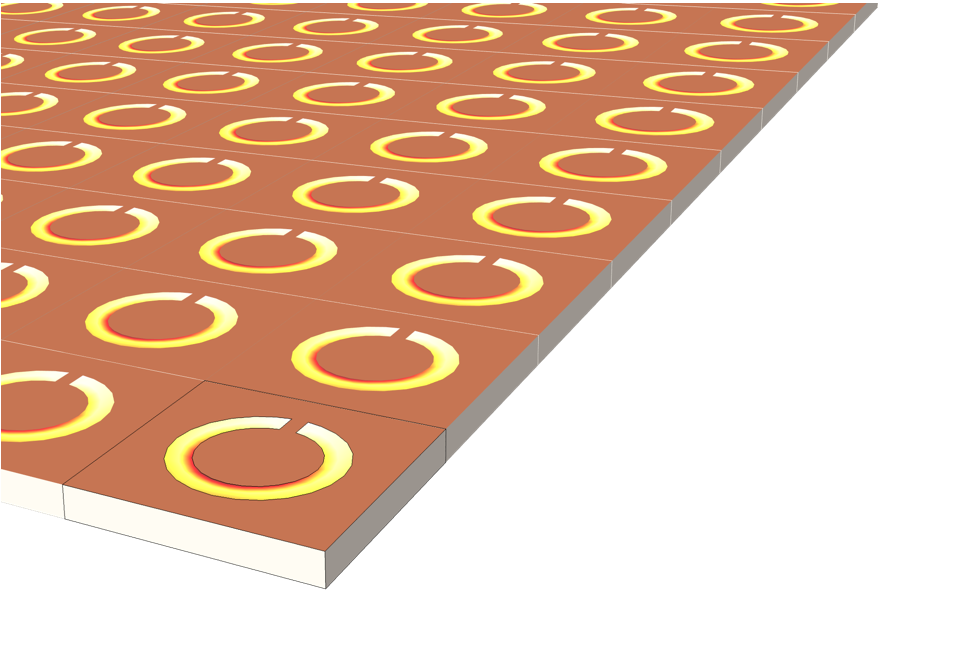
One unit cell of the complementary split ring resonator is modeled with periodic boundary conditions to simulate an infinite 2D array. Perfectly matched layers at the top and bottom of the unit cell absorb the excited and higher-order modes.
Using the Application Builder in COMSOL Multiphysics, you can create a user-friendly simulation app from the frequency-selective surface model to share with your colleagues or customers. They do not need to know how to use simulation software to run the app that you design for them, but they can still benefit from its modeling capabilities for shielding product design. Anything that is parameterized can become an input in an app and users just need to type whatever value they want.
TheFrequency Selective Surface Simulatoris an example app that provides five popular FSS unit cell types, with two predefined polarizations and propagation at normal incidence. The analysis includes the reflection and transmission spectra, the electric field norm on the top surface of the unit cell, and the dB-scaled electric field norm shown on a vertical cut plane in the unit cell domain.
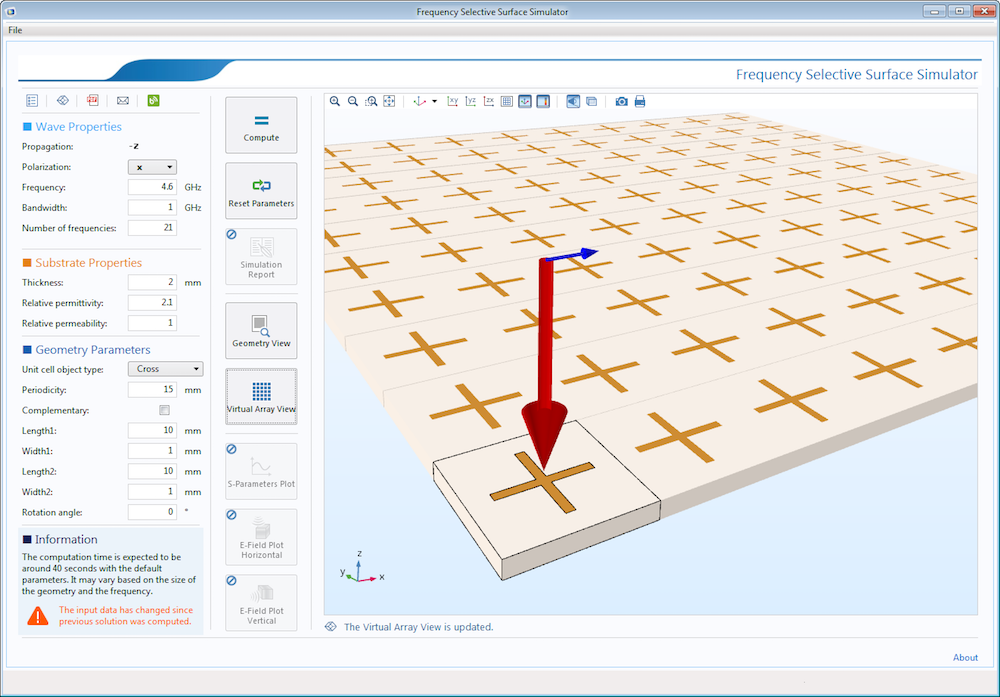
The user interface with a 10×10 virtual array view of the Frequency Selective Surface Simulator.
Further Reading
- Download the tutorial models and app featured in this blog post:
- Read more about theBlockFaraday Cage device in thisblog post fromTech Crunch



Comments (0)